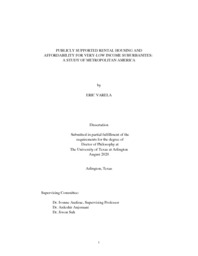
ATTENTION: The works hosted here are being migrated to a new repository that will consolidate resources, improve discoverability, and better show UTA's research impact on the global community. We will update authors as the migration progresses. Please see MavMatrix for more information.
Show simple item record
| dc.contributor.advisor | Audirac, Ivonne | |
| dc.creator | Varela, Eric | |
| dc.date.accessioned | 2022-01-20T18:09:47Z | |
| dc.date.available | 2022-01-20T18:09:47Z | |
| dc.date.created | 2020-08 | |
| dc.date.issued | 2020-09-08 | |
| dc.date.submitted | August 2020 | |
| dc.identifier.uri | http://hdl.handle.net/10106/30178 | |
| dc.description.abstract | This dissertation is about subsidized housing and its provision in the contemporary metropolis, with particular focus on suburbs. Subsidized housing has typically been conceived as fundamentally an urban issue given its historical roots largely centered on addressing destitute slums and inner-city poverty (Stoloff, 2004). Yet today’s American metropolis is fundamentally different from that which existed one hundred, fifty, or even twenty-five years ago. Suburbs are more prominent now than ever before, both as economic centers and diverse cultural mosaics in metropolitan America (Zhang & Logan, 2017). In fact, suburbs are now home to more impoverished Americans than principal cities (Kneebone, 2017).
Research on the evolution of subsidized housing programs, the geographic and policy landscape of the suburbanizing metropolis, and components of regional cohesion inform the hypotheses of this study. Three regression models were used to evaluate these hypotheses using 107 of the largest Metropolitan Statistical Areas in the United States. The first hypothesis suggests that greater availability of publicly supported rental housing (PSRH) will be associated with lower levels of cost burden among Very Low-Income (VLI) renters, whereas the second emphasizes the importance of equitable distributions of PSRH. The third hypothesis posits that greater regional cohesion will be associated with increased availability of PSRH in metropolitan areas.
The analysis supports the first hypothesis, showing a strong relationship between higher PSRH levels and lower rates of cost burden for VLI renters in suburbs and throughout metropolitan areas. Regression analysis also supports the theoretical significance of PSRH distribution in limiting cost burden among VLI renters. The impact of regional cohesion on PSRH availability is substantiated in looking at metropolitan areas as a whole, but not within their suburbs alone.
Findings suggest the production of additional subsidized housing can help combat cost burden among VLI renters. The analysis also suggests fair share agreements and collaboration among regional entities can serve to promote the production and equitable distribution of subsidized housing within metropolitan areas. Further research might build on this dissertation through case studies focused more closely on relationships between public and private subsidized housing providers within individual metropolitan regions. | |
| dc.format.mimetype | application/pdf | |
| dc.language.iso | en_US | |
| dc.subject | Affordability | |
| dc.subject | Affordable housing | |
| dc.subject | HUD | |
| dc.subject | Publicly supported rental housing | |
| dc.subject | Renters | |
| dc.subject | Subsidized housing | |
| dc.subject | Suburbanization | |
| dc.title | Publicly Supported Rental Housing and Affordability for Very Low-Income Suburbanites: A Study of Metropolitan America | |
| dc.type | Thesis | |
| dc.degree.department | Urban and Public Affairs | |
| dc.degree.name | Doctor of Philosophy in Urban Planning and Public Policy | |
| dc.date.updated | 2022-01-20T18:09:47Z | |
| thesis.degree.department | Urban and Public Affairs | |
| thesis.degree.grantor | The University of Texas at Arlington | |
| thesis.degree.level | Doctoral | |
| thesis.degree.name | Doctor of Philosophy in Urban Planning and Public Policy | |
| dc.type.material | text | |
| dc.creator.orcid | 0000-0002-7960-9964 | |
Files in this item
- Name:
- VARELA-DISSERTATION-2020.pdf
- Size:
- 1.338Mb
- Format:
- PDF
This item appears in the following Collection(s)
Show simple item record


